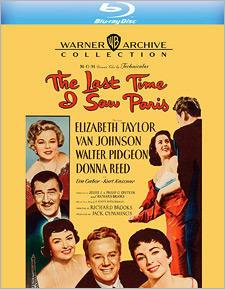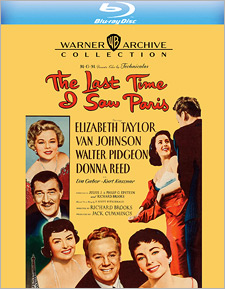Last Time I Saw Paris, The (Blu-ray Review)

Director
Richard BrooksRelease Date(s)
1954 (July 25, 2023)Studio(s)
Metro-Goldwyn-Mayer (Warner Archive Collection)- Film/Program Grade: B+
- Video Grade: A
- Audio Grade: A
- Extras Grade: B-
Review
Though only slightly above average as romantic melodrama, The Last Time I Saw Paris (1954) is surprisingly good overall. It’s a rare big-scale MGM production that has lapsed into the public domain, resulting in it becoming widely available from myriad third-rate video distributors for years, all using fourth-rate video transfers. So how did The Last Time I Saw Paris fall into public domain? On the film’s title card, the copyright date should have been “MCMLIV” (“1954”) but instead read “MCMXLIV” (“1944”). That meant its copyright renewal came up ten years earlier than MGM’s legal department expected. They missed their window of opportunity, and now anyone can make and sell copies.
Studios are usually disinclined to remaster such films, but Warner Archive’s 4K remaster from the original camera negative is a wonder. I was expecting something with dull color and monophonic audio, but no. The 1.75:1 widescreen presentation is appropriately sharp with excellent color—it looks superb. Even more of a surprise is that while WB Archive’s official press release (and some reviews) list a DTS-HD Master Audio 2.0 mono track, the movie is clearly in full 2.0 stereo.
Loosely based on F. Scott Fitzgerald’s 1930 short story Babylon Revisited, the film stars Van Johnson as Paris-based Stars and Stripes reporter Charles Wills. On V-E Day, all of Paris is ecstatic with the news of Germany’s surrender, Charles making his way to regular hangout Café Dhingo where he meets and becomes attracted to another American, Marion Ellswirth (Donna Reed). She invites him to her father’s lavish party that night where Charles is introduced to Marion’s younger sister, Helen (top-billed Elizabeth Taylor), the same woman who anonymously but passionately kissed him along the crowd-packed Champs-Élysée earlier that same day.
At the party it turns out their father, James Ellswirth (Walter Pidgeon, very good in an atypical role), is part of the Lost Generation of expat Americans, virtually penniless but living it up like a king, if always teetering on a financial precipice. Carefree Helen takes after her father while Marion has an almost opposite personality, careful and cautious to a fault. To Marion’s disappointment, Charles falls in love with Helen instead of her. They marry and soon have a daughter, Vicki (played as a child by Sandy Descher, the girl from Them!), but given Charles’s meager income they’re forced to live in James’s large house.
Charles is also an aspiring novelist anxious to quit his job as a reporter. When one of his colleagues (John Doucette) sells a story for $15,000, Charles becomes jealous and starts drinking heavily. Later, oil is discovered on seemingly worthless Texas property James gave Charles as a dowry, and the family is suddenly rich—but Charles’s manuscripts still keep getting rejected and his drinking gets worse. His increasing surliness, combined with Helen’s carefree lifestyle (and thus seeming indifference to Charles’s unhappiness), puts a strain on their marriage. Each is eventually drawn to other potential partners: she to tennis pro Paul (27-year-old Roger Moore in his Hollywood debut), he to wealthy (multi-)divorcée Lorraine Quarl (Eva Gabor). Can their marriage survive? What’ll happen to little Vicki?
The Last Time I Saw Paris gets a perfect score as a Hollywood production combating plummeting movie attendance in the ‘50s. In this case it a) is in widescreen with stereophonic sound; b) has not one but several big stars in its cast (Taylor, Johnson, Reynolds, and Pidgeon); and c) makes use of an exotic, fall-flung locale, in this case Paris and, briefly, Monaco. On this last point The Last Time I Saw Paris is especially impressive. A good chunk of the picture was made on MGM’s backlot, but there are many impressive scenes of (mostly) Van Johnson all over early postwar Paris, and the integration of location and Hollywood-shot footage is as seamless as I’ve ever seen in a 1950s picture. Further, at the beginning, it also expertly integrates color footage of Paris on V-E Day; the matching is impressive.
The Fitzgeraldian aspects of the short story (adapted from the author’s real-life) are, to say the least, muted and sanitized as only MGM could do, but they’re there. Though its time and place have shifted to early postwar Paris, it methodically and more or less believably follows a quartet of characters over a roughly nine-year period of hopes and regrets. Taylor believably ages from bubbly 20-something to a more matronly, unhappily married mother. Van Johnson, an underrated actor, was reportedly offscreen a brooding, melancholy character quite unlike his early career screen image; if that’s true maybe he tapped into whatever self-loathing he may have felt, as his later scenes in the film play emotionally authentic. Donna Reed, fresh from her Oscar win for From Here to Eternity, is a little shortchanged in a part that’s largely limited to the first and last ten minutes of the story.
Extra features are limited to a trailer (narrated by Paul Frees trying to suggest Orson Welles) that’s full-framed and sourced from standard-def video; and the Tom & Jerry (CinemaScope) cartoon Touché Pussycat (1954, running 6:40), this one mastered in high-def.
Generally, I’m not too fond of this sort of romantic drama, especially not from MGM, but The Last Time I Saw Paris is highly watchable—it’s screenplay by Jules & Philip Epstein and director Richard Brooks is better than I was expecting, the performances are good, and the locations and production values really shine in this stellar video transfer.
- Stuart Galbraith IV

